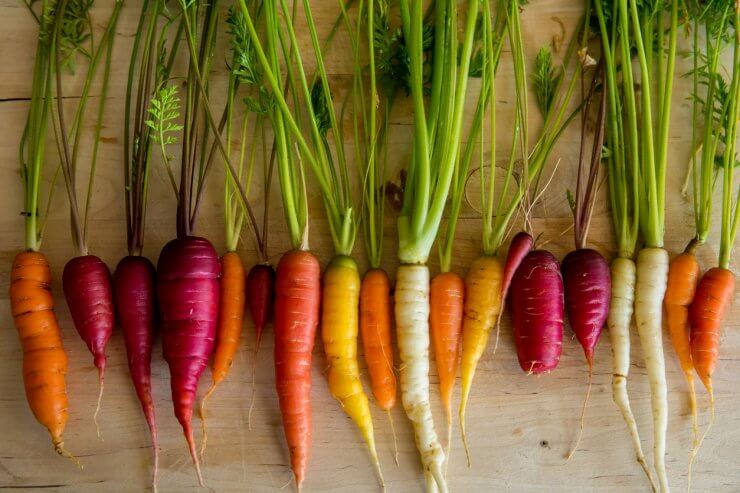
Fresh orange carrots from the garden

Fresh orange carrots from the garden
Nothing compares to the taste of carrots fresh from the garden; even organic carrots from the market run a distant second. There’s something so satisfying about pulling a carrot from the ground, giving it a good rinse, and savoring that first bite right there in the garden.
My first solid memory of carrots fresh from the garden was visiting my grandmother. She always had a well-tended garden just bursting with flavor. Picking carrots was one of my favorite childhood activities. And now, of course, it’s one of my favorite gardening activities.
Carrots sometimes get a bad rap as being difficult to grow. They’re not hard to grow, but you do need the right soil preparation and a bit of patience: carrot seeds take a while to germinate, and their growing cycle is fairly long. But in the end, you’ll be so happy with the flavor of your own homegrown carrots—you’ll never go back to store-bought carrots again!
Most of the carrots you see in the market are orange, but that’s a recent development. Carrots used to come in a wild rainbow of colors: white, red, yellow, purple—and with more color inside. Those heirloom varieties are available now for home gardeners. Not only do they give you a more colorful garden, they all offer up a wide variety of healthy antioxidants.
Carrots are the not-so-distant cousins of Queen Anne’s lace—that plant with the lacy disk of tiny flowers at the top of slender stems. Look closely and you’ll see those flowers look a lot like domestic carrots when they flower. Dig up some Queen Anne’s lace (a lot of people think of it as a weed; I think of it as a wildflower) and you’ll find tiny carrots below the stems. But don’t bother trying to eat them; they’re too small, and not tasty.
The domestic carrots we enjoy are classified as Daucus carota L. var. sativus Hoffm. That’s a long name for our delicious root vegetable that comes from the Carrot family—also known as Apiaceae/Umbelliferae.
Carrots come in five main types, from foot-longs to golf ball size, which we detail in Types of Carrots. You can grow them pretty much anywhere they can get six to eight hours of sunlight—in open land, raised beds, or containers. The key to growing carrots well is to have loose, loamy, sandy soil that’s free of obstructions. You want to give those roots room to roam!
A Brief History of Carrots

Assortment of colorful carrots on a wooden cutting board
The carrot was first domesticated in Persia in the 10th century and was purple or white, rather than orange. Apparently, some cross-pollination occurred (as it does), and carrots went from purple or white to yellow, and then to orange.
Persia, lying along the ancient Silk Road trade route, was the ideal way for carrots to make their way both east and west. Eventually, there were carrots in the Mediterranean region and western Europe by the 11th century, and in India, China, and Japan by the 14th century.
The Dutch get credit for refining carrot cultivars that form the foundation of our current carrots. The word “carrot” first entered the English vocabulary in the 1500s; the English borrowed the word from the French, who got it from the Romans, who borrowed it from the Greeks. In Old English, the word for carrot was the same as the word for parsnip, since both were white at the time. Even today, some European languages use the same word for “root” as they do for “carrot.”
Even as far back as the sixth century, you can see depictions of what we can recognize as carrots. The Juliana Anicia Codex of 512 A.D includes illustrations of three different carrots: one cultivated, one wild-cultivated, and one wild. This is the oldest recorded reference to the cultivated carrot.
Today, Americans eat almost 10 pounds of carrots a year. The world’s largest producer of carrots is Grimmway Farms in Bakersfield, California. The farm handles about 10 million pounds of carrots a day. This company gets credit for making baby carrots popular.
Holtville, California, to the southeast of Bakersfield, calls itself the Carrot Capital of the World and has been holding an annual Carrot Festival since 1947. The World Carrot Museum, an online virtual museum, is dedicated to all things carrot. There you can find information on carrot festivals around the world, plus recipes, trivia, and more. When April 4 next rolls around, take a moment to appreciate the versatile vegetable that is the carrot; April 4 is International Carrot Day.
Did you know about the history of carrots? Are you excited to try growing them? Let us know what you think.




I really appreciate the history you include that provides the “root” experience and progression of carrot transformations. Thank you!